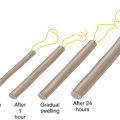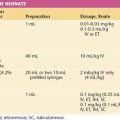Chapter 33 Dysfunctional Uterine Bleeding
Abnormal bleeding patterns are defined in Box 33-1. Taken together, these abnormal patterns are sometimes designated as menometrorrhagia.
BOX 33-1 Common Abnormal Bleeding Patterns
Abnormalities of menstrual bleeding are thought to be associated with alterations in endometrial vascular homeostasis. A normally efficient menstrual cycle is discussed in detail in Chapter 4, and the normal events are briefly summarized as follows.
 Diagnosis
Diagnosis
The diagnosis of DUB is usually made by excluding other causes of AUB. A possible unexpected pregnancy should always be ruled out initially. Box 33-2 lists possible causes of AUB to be considered. A pelvic examination must be performed to verify that the source of bleeding is uterine and not the result of a cervical, rectal, vaginal, vulvar, or urethral lesion. Iatrogenic causes such as oral contraceptive–induced breakthrough bleeding or bleeding associated with an intrauterine device should be considered. Dyscrasias of the blood such as von Willebrand’s disease should be ruled out. Systemic diseases such as liver, renal, or thyroid conditions may represent treatable causes of AUB. Trauma, although unusual, is an occasional cause of vaginal and even uterine bleeding and should be considered at the time of the pelvic examination. Organic causes of AUB include tumors, infections, and complications of pregnancy. Benign tumors and growths include endocervical and endometrial polyps, leiomyomas (uterine fibroids), adenomyosis, and endometrial hyperplasia. Malignant neoplastic conditions include cervical and uterine cancers. Infections that may cause AUB include cervicitis, endometritis, and pelvic inflammatory disease.
BOX 33-2 Nondysfunctional Causes of Abnormal Uterine Bleeding
Two investigations are most useful for confirming DUB: a pelvic ultrasound and an endometrial biopsy. If they are both normal and show nothing more than a nonsecretory endometrium, a presumptive diagnosis of DUB is highly likely. Other tests and procedures that may be useful to exclude other causes of AUB are listed in Box 33-3.
 Management
Management
The management of DUB becomes relatively clear once other, more serious causes of bleeding have been excluded, particularly endometrial or cervical cancer. For less significant bleeding, observation and expectant management may be reasonable. Box 33-4 lists the appropriate hormonal management of significant DUB.
BOX 33-4 Hormonal Management of Dysfunctional Uterine Bleeding
Continued Management after Massive Bleeding Has Abated
Management of Moderate Menometrorrhagia
Estrogen-Progestin Combination
Cyclic Progestin
Mirena Intrauterine System with Levonorgestrel-Releasing Intrauterine Device
The more common and less urgent type of DUB is best managed by cyclic estrogens with a progestin added in the latter 10 to 15 days of the 25-day estrogen cycle (see Box 33-4). A 5- to 7-day withdrawal bleed is expected each month as the medications are withdrawn on the 21st or 25th day. The cycle is repeated each month for 3 to 6 months, after which a normal pattern may be spontaneously established. Oral contraceptives should not be used for women in their 40s who are smokers, because of the high content of estrogens and their association with thrombophlebitis and myocardial infarction. Cyclic progestins alone may be used for younger patients who are likely to have sufficient endogenous estrogens to prime the endometrial progesterone receptors. The Mirena intrauterine system, which releases levonorgestrel, has been reported to be useful for treating DUB. It has a 55% 5-year continuation rate and a 30% early discontinuation rate in women being treated for DUB. These drugs are unlikely to be effective after prolonged bleeding. Only when these measures are ineffective should a dilation and curettage or hysteroscopy and biopsy be performed.
Association of Professors of Gynecology and Obstetrics. Clinical Management of Abnormal Uterine Bleeding, Educational Series on Women’s Health Issues. Boston: Jespersen and Associates; 2002.
Hillard P.J.A. Benign diseases of the female reproductive tract. In: Berek J.S., editor. Berek and Novak’s Gynecology. 14th ed. Philadelphia: Lippincott Williams & Wilkins; 2007:461-467.
Mukherjee K., Jones K. The treatment of DUB with Mirena IUS: A survival analysis. Gynecol Surg. 2005;2:251-254.




